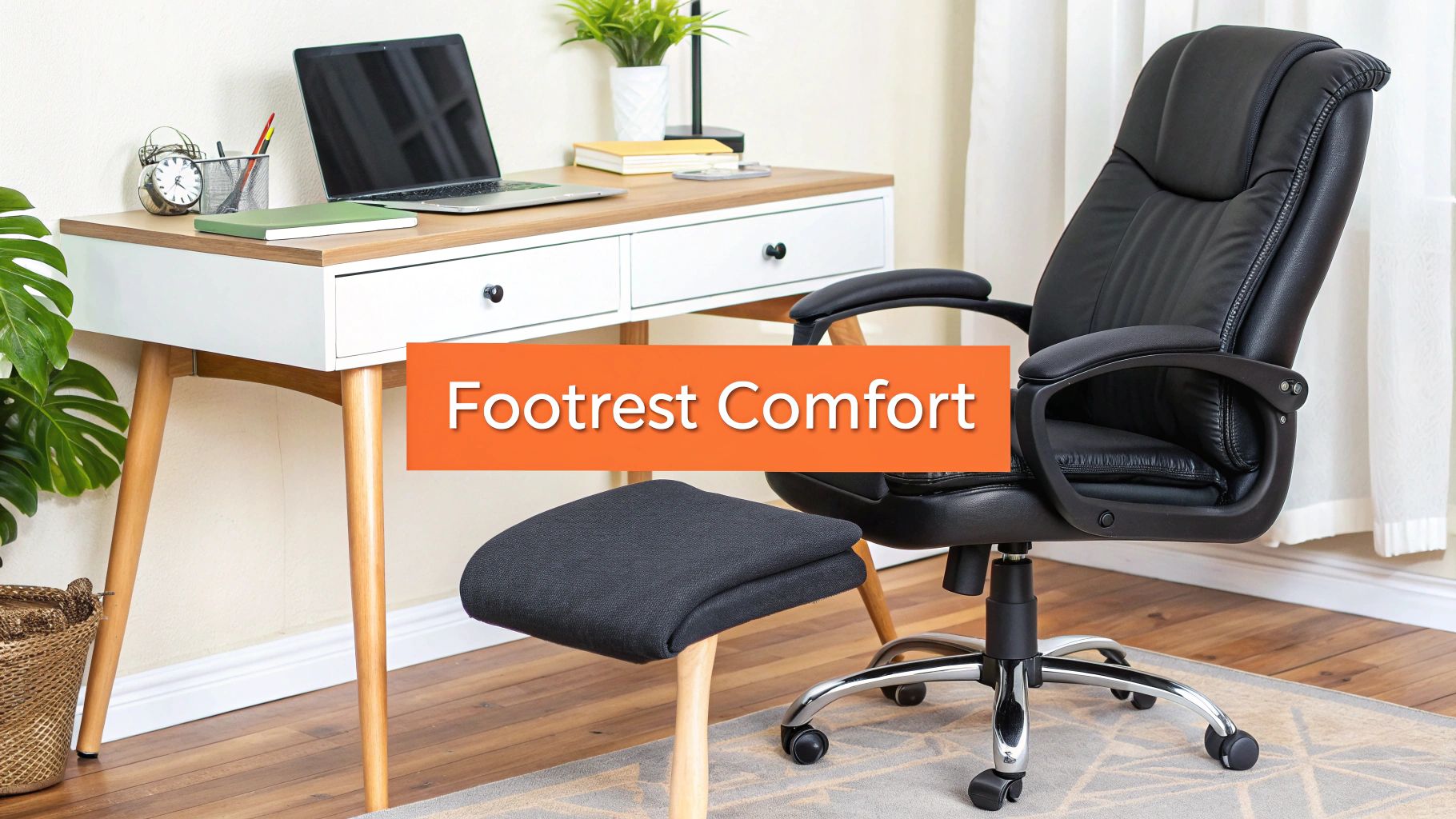Let’s be honest, an ergonomic office chair with a footrest isn't just a cushy seat. It's a game-changer for anyone who spends their day at a desk. We're talking about a genuine tool for improving circulation, sorting out your posture, and warding off that all-too-familiar end-of-day exhaustion. This simple addition elevates a standard ergonomic setup into something truly exceptional, giving you the kind of targeted support that keeps you focused and pain-free.
Why a Footrest Completely Changes the Game
A quality ergonomic chair does a great job of supporting your back, but it's the integrated footrest that completes the picture by looking after your entire lower body. It’s this one feature that turns a passive, static sitting experience into something far more dynamic and healthy, with real, tangible effects on your well-being and productivity.
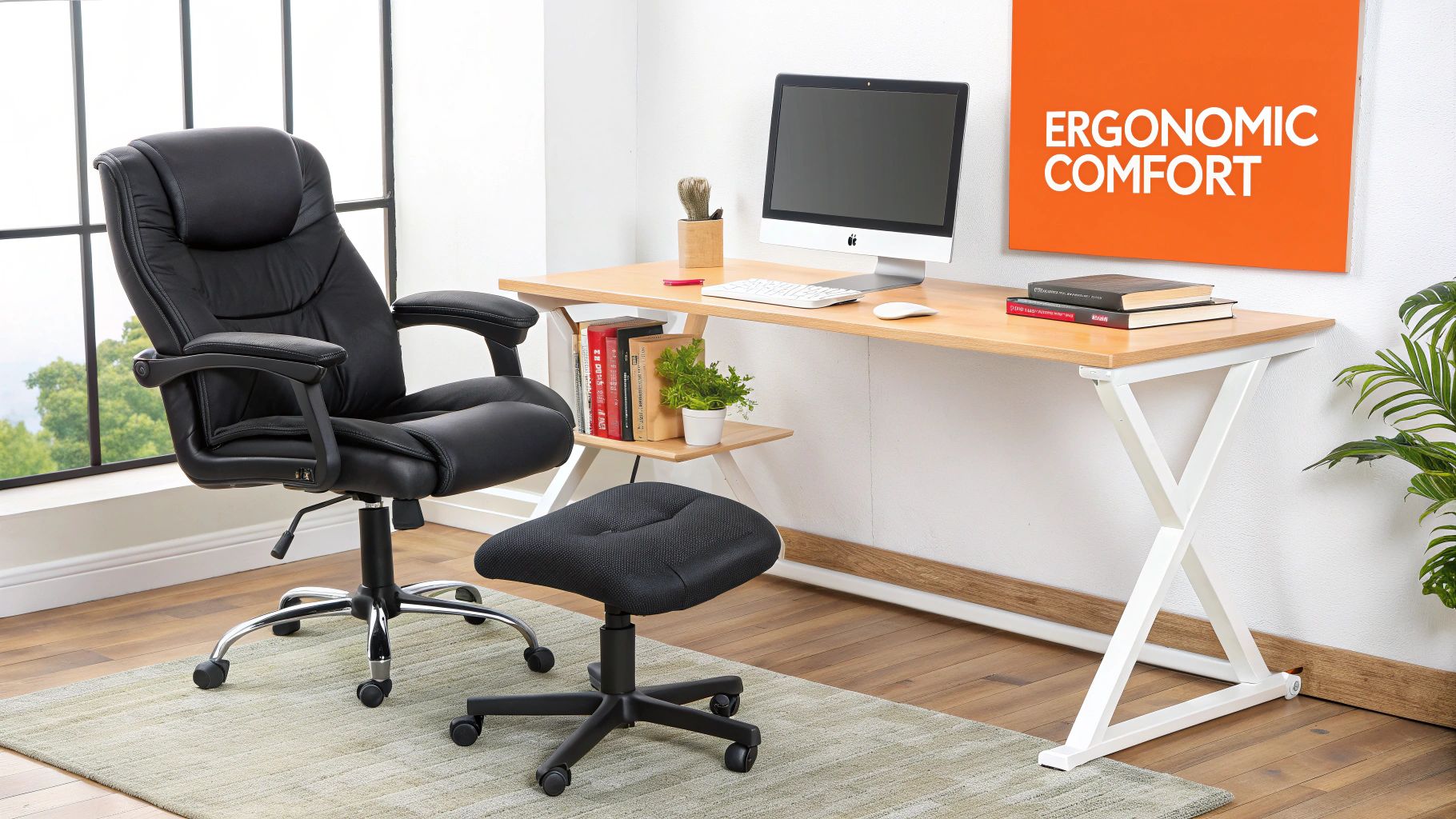
Think of it as the difference between good and great. A standard chair helps prevent aches and pains, but an ergonomic office chair with a footrest actively promotes healthier habits all day long.
The Simple Science Behind It
When you’re sitting down for hours on end, gravity isn't your friend. Blood tends to pool in your lower legs, which can lead to swelling, discomfort, and a general feeling of sluggishness. Popping your feet up on a footrest completely changes this dynamic.
It encourages what a lot of us in the industry call 'active sitting'. You start naturally shifting your position—feet on the floor when you're zeroed in on a task, then feet up during a phone call or while reading through a long document. These subtle movements keep different muscle groups engaged and prevent that stiff, locked-in feeling.
A footrest helps blood flow more easily from your legs back to your heart, which immediately lowers the risk of circulatory problems. This simple tweak also takes pressure off your lower back and distributes your weight more evenly across the chair.
The Difference You'll Actually Feel
The impact of this extra support isn't just theoretical; you'll feel it. Imagine getting through a full eight-hour day without that nagging ache in your lower back or that restless feeling in your legs. That's the upgrade a footrest brings to the table.
Here are a few of the real-world benefits I see people experience all the time:
- Less Pressure on Your Spine: Lifting your legs even slightly tilts your pelvis forward. This helps your lower back maintain its natural curve, which is a massive relief for your spine.
- Sharper Focus: When your body is genuinely comfortable and supported, your brain is free to concentrate on your work instead of being distracted by discomfort.
- Flexible Comfort: A retractable footrest is the best of both worlds. You can kick your feet up during a long meeting to relax, then slide it away when you need to lean forward and get down to business.
This isn't just a niche idea, either. The growing demand for truly ergonomic solutions is clear in the market. Australia's office furniture sector, currently valued at around USD 2.46 billion, is expected to climb to USD 3.03 billion. This growth is being fuelled by people like you, who are looking for furniture that genuinely improves comfort and posture.
It's this commitment to smarter, healthier design that drives brands like Pago International to create chairs with these features built right in. You can explore a quality Pago chair on our website or at Officeworks to get a feel for what this level of integrated support looks like. For a deeper dive, our guide on why you might need a footrest for your office chair has even more information.
Choosing the Right Chair for Your Work Style
Finding the perfect ergonomic chair can feel a bit overwhelming. With a sea of features and technical jargon, it’s easy to get bogged down. The secret? Stop focusing on the marketing buzzwords and start thinking about how you actually work. Your day-to-day tasks and habits are what should really guide your choice.
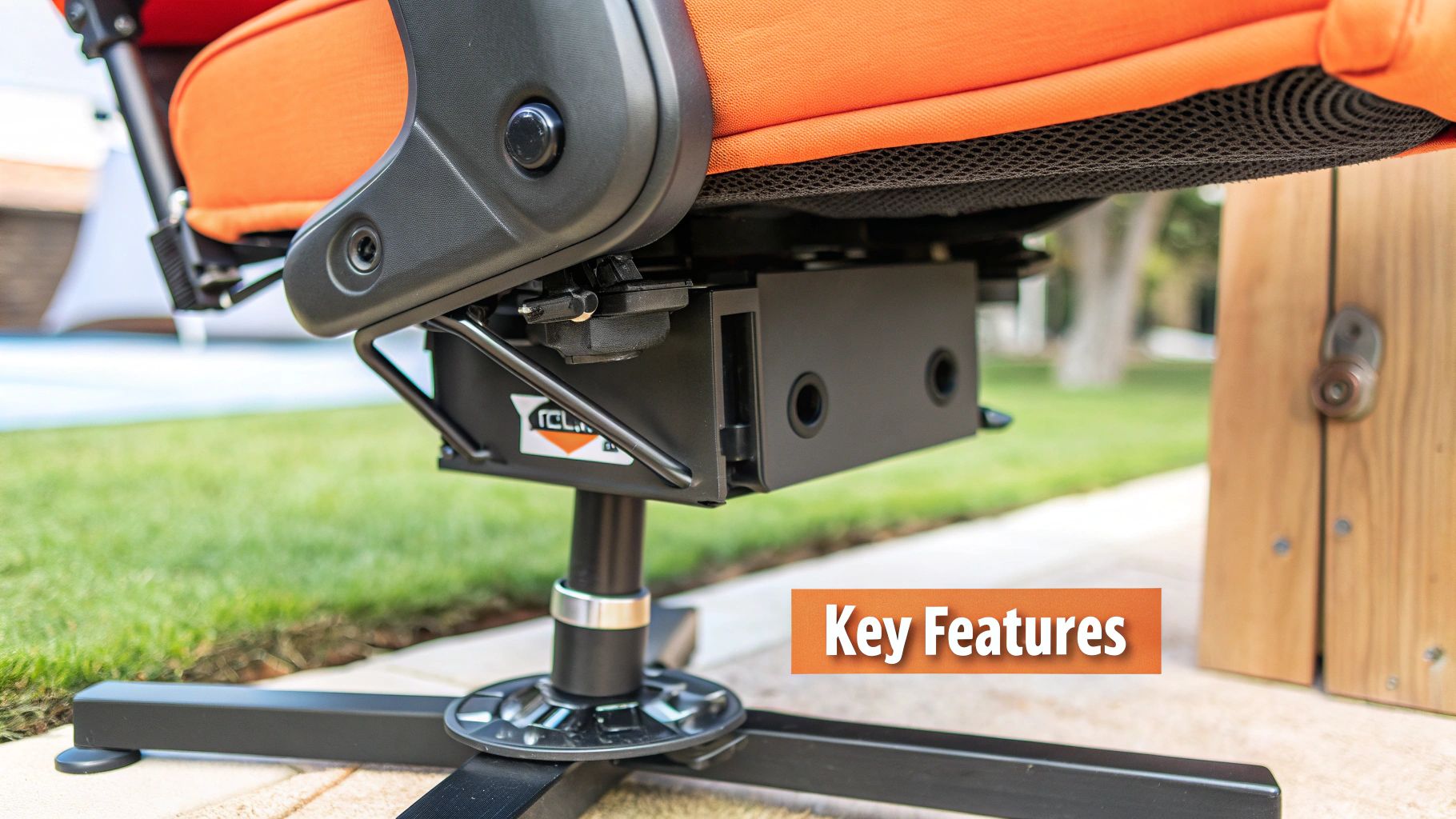
This simple shift in mindset makes all the difference. An ergonomic office chair with a footrest isn't a one-size-fits-all product. Its real value comes from how well it syncs with your specific needs. Maybe you're a graphic designer who needs rock-solid arm support for detailed work, or a writer who values great lumbar comfort for long thinking sessions.
Match the Features to Your Job
Let's get practical. Think about your daily routine. Do you spend hours hunched over detailed design work, needing your arms to be perfectly stable and positioned? If that’s you, then 4D armrests—the kind that adjust up, down, forward, back, and sideways—are non-negotiable.
On the other hand, if you’re a writer or a strategist who often leans back to brainstorm, a responsive recline mechanism and top-notch lumbar support will be your best friends. It’s about finding the features that support your specific movements.
The demand for these specialised chairs is booming. The global ergonomic chair market was valued at nearly USD 12.21 billion and is expected to climb to around USD 25.17 billion by 2032, with a 7.50% annual growth rate. This trend is especially noticeable here in Australia, where hybrid work models have made us all more conscious of our home office setups. We’re realising just how much features like adjustable height, proper lumbar support, and integrated footrests can do for our posture and overall well-being during a long day.
To help you narrow down what's truly important, here’s a quick checklist breaking down the must-have features versus the nice-to-haves.
Key Feature Checklist for Your Ergonomic Chair
Thinking through this list will give you a much clearer idea of what to prioritise when you start shopping. Focus on getting the essentials right, and the rest will fall into place.
Decoding Footrest Types
It's also worth knowing that not all footrests are the same. The type you choose can make a big difference to your workflow and comfort.
- Retractable Footrests: These are brilliant. They’re built right into the chair, sliding or flipping out from under the seat when you need them. They save floor space and mean you’ve always got support ready to go. For most people, this is the ideal setup.
- Adjustable Footrests: While many retractable models are fixed, some premium chairs let you adjust the footrest's height or angle. This offers a more customised level of support, which can be great if you have specific needs.
- Static Footrests: These are the separate stools or platforms you place on the floor. They offer flexibility in where you put them, but they also take up valuable floor space and can be a bit of a hassle to move around.
For the vast majority of us, a built-in, retractable footrest hits the sweet spot between convenience and support. It stays out of your way when you’re focused at your desk and is right there when you want to lean back for a phone call or to review a document.
Material World: Comfort Meets Durability
Finally, the material of your chair plays a huge role in both its comfort and how long it will last. Your choice here often comes down to personal preference and your office environment.
- Mesh: Fantastic for keeping you cool, especially in warmer climates. Mesh is highly breathable and conforms to your body, giving you great support without creating uncomfortable pressure points.
- Leather: The classic executive choice. It looks premium, feels great, and is very durable and easy to clean. The only downside is that it can be less breathable.
- Fabric: This option offers a soft, comfortable feel and usually comes in the widest range of colours. It’s inviting and cosy but can be trickier to clean than leather or mesh.
Ultimately, picking the right chair is about matching its capabilities to your daily reality. When you take a moment to analyse your needs, you can find a chair that genuinely supports you. Brands like Pago offer an extensive range of ergonomic options, making it easier to find a perfect fit for your work style.
Setting Up Your Chair for Perfect Posture
So, your new ergonomic office chair has finally arrived. The unboxing is always exciting, but the real magic happens when you start adjusting it. This is where you move beyond the generic instruction manual and truly mould the chair to your body. It's the key to unlocking the comfort and health benefits you paid for.
Think of it less as assembly and more as a personal fitting. Every lever and knob is there for a reason, and with a few smart tweaks, you can transform a good chair into your perfect chair. Let's walk through how to get this right. For a real-world example, imagine we're working with a model like a Pago chair from Officeworks to make these adjustments tangible.
The Foundation of Good Posture: The 90-90-90 Rule
Before you touch anything else, you need to understand the 90-90-90 rule. I've seen it time and time again—it’s the absolute cornerstone of a great ergonomic setup and your best guide for achieving a neutral, low-strain posture.
Here’s the breakdown:
- Ankles: Aim for a 90-degree angle. Your feet should be flat on the floor or, if needed, on your footrest.
- Knees: These should also be bent at about 90 degrees, with your thighs running parallel to the floor.
- Hips: You’re looking for a 90 to 100-degree angle here, allowing your back to rest naturally against the chair's backrest for full support.
Start with the seat height. Adjust it up or down until your feet are planted firmly on the floor and your knees hit that 90-degree sweet spot. If you find your feet are dangling to achieve the right knee angle, that's your cue—it's time to bring in the footrest.
Adjusting the Footrest: Avoiding the Common Mistake
The footrest on an ergonomic office chair with a footrest is one of its most valuable—and misunderstood—features. Its primary job isn't for kicking back and relaxing; it’s a support tool for when your feet can't comfortably reach the floor after you've set the correct seat height for your desk.
From my experience, the single biggest mistake people make is setting the footrest way too high. This just creates uncomfortable pressure behind your knees and can actually restrict circulation. The goal is support, not elevation.
Your feet should rest flat and feel fully supported, maintaining that crucial 90-degree knee bend. A good rule of thumb is to ensure there’s a small gap—about two to three fingers' width—between the back of your knees and the front edge of your seat. This little bit of space is vital for preventing blood flow restriction.
This simple visualisation shows exactly how a correctly used footrest benefits your posture and circulation.
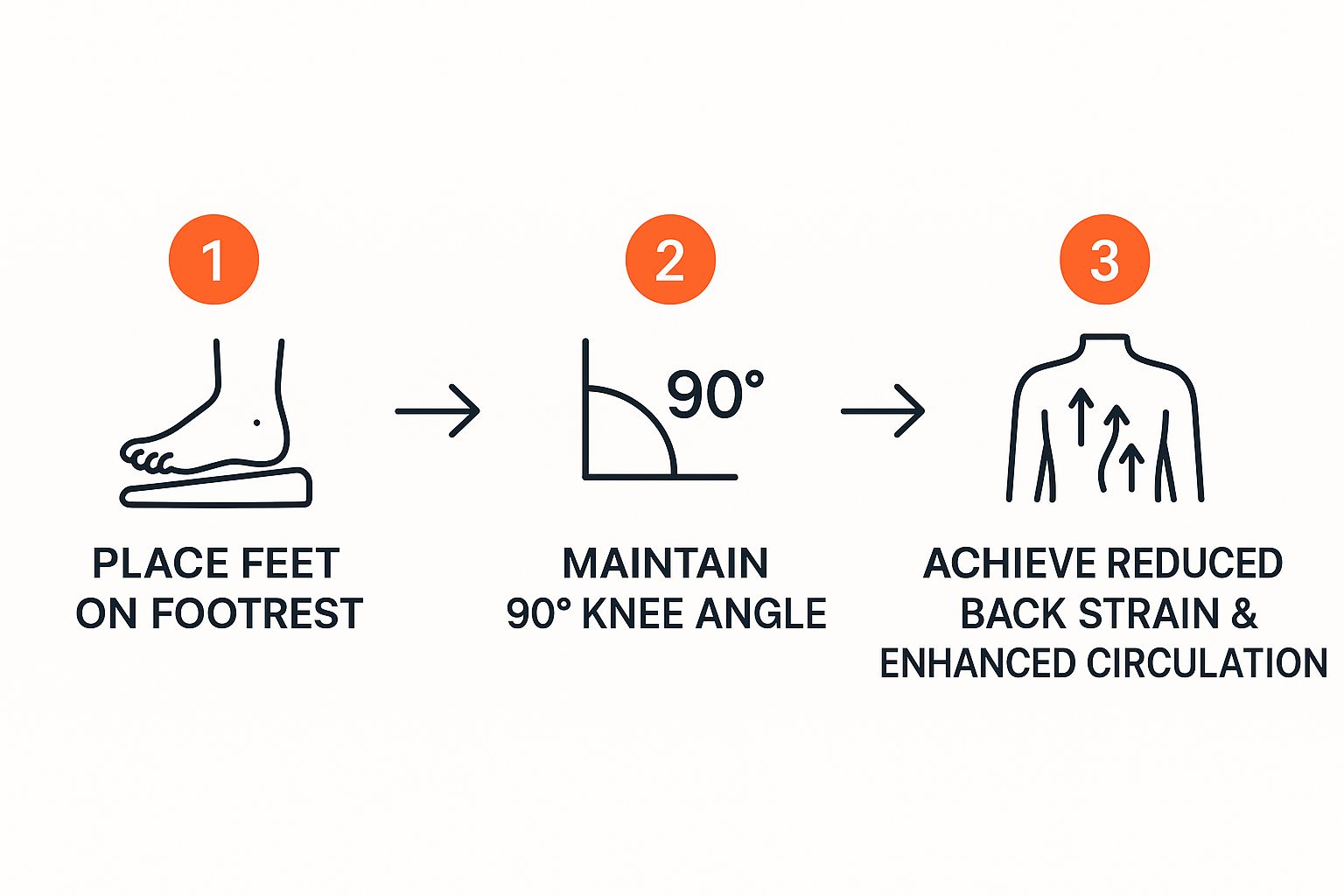
As the image shows, getting your feet properly placed on the footrest doesn't just feel better; it actively reduces back strain and improves blood flow.
Fine-Tuning for a Custom Fit
Alright, with the seat height and footrest dialled in, it's time for the final touches. These are the small adjustments that make a chair feel like it was custom-built just for you.
- Lumbar Support: Slide the lumbar cushion up or down until it nestles perfectly into the natural curve of your lower back. You want gentle support, not a hard lump pushing you forward.
- Armrests: Adjust the armrests so your shoulders can completely relax. Your elbows should be bent at roughly 90 degrees, with your forearms resting comfortably. No shrugging!
- Recline Tension: Play with the tension knob. You should be able to lean back with a gentle push, feeling supported throughout the motion, not like you're about to be launched backwards.
Spending just ten minutes on these settings can completely change your workday comfort and long-term well-being. If you're looking for more tips on setting up your space, you might find our guide on what to look for in an ergonomic chair for a home office helpful.
Building a Healthier Workday Routine
An ergonomic chair is a fantastic tool, but its real magic happens when you weave it into a bigger picture of workday wellness. It’s all about moving beyond just sitting and embracing a more dynamic, energised way of working. This isn't about setting strict rules for yourself; it's about building small, simple habits that genuinely make a huge difference to how you feel.
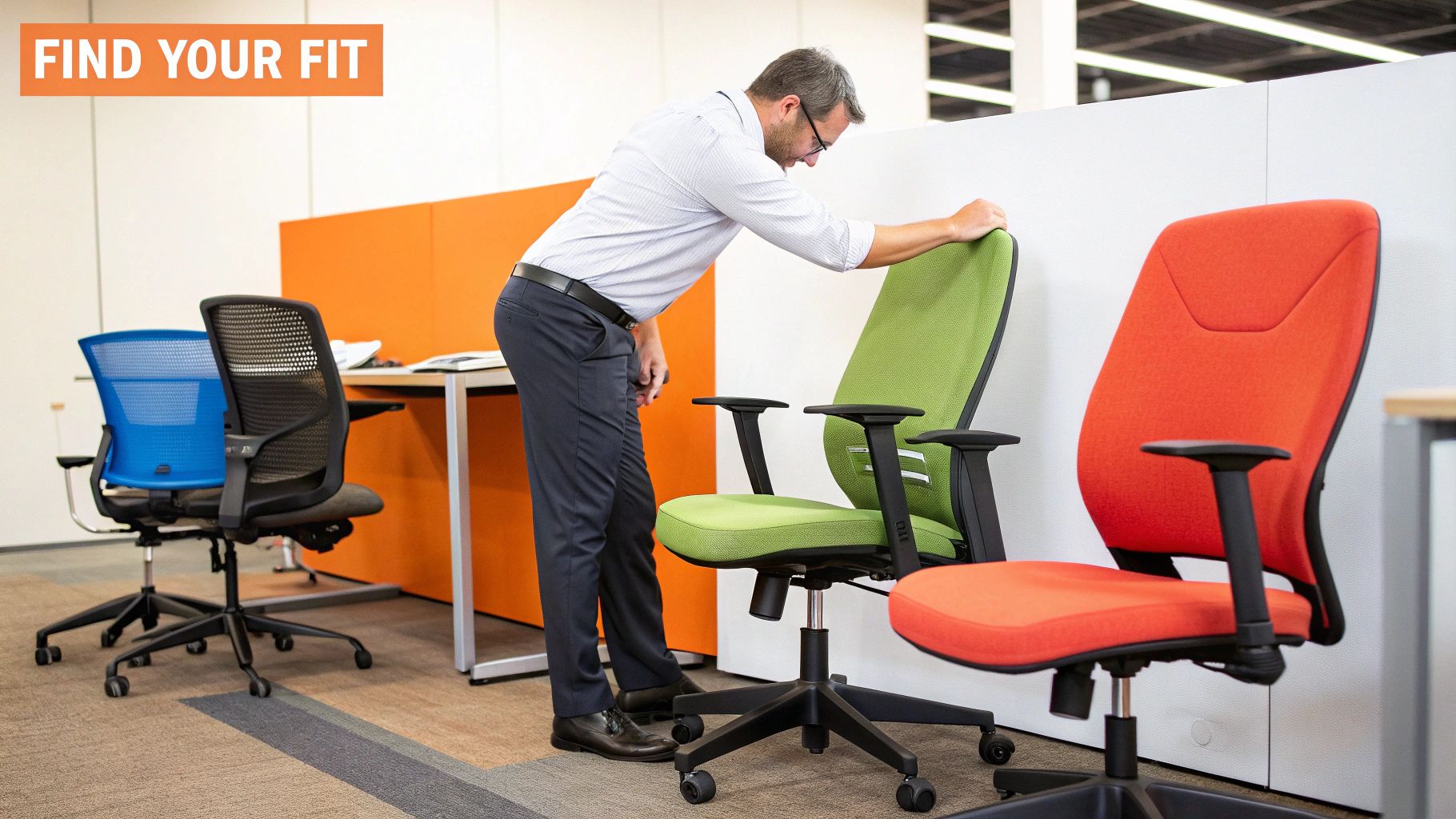
The key is to use your ergonomic office chair with a footrest with purpose. Think of that footrest as a feature that changes with your tasks. Got a long video call or a hefty report to read through? Extend the footrest to encourage better circulation and give your legs a break. But when it's time to get into some serious typing, tuck it away so you can sit upright with your feet planted firmly on the floor.
Practising Active Sitting Throughout Your Day
You might have heard the term 'active sitting', and it's a wonderfully simple but powerful idea. It just means making frequent, small tweaks to your posture to stop your muscles from getting stiff and sore. An ergonomic chair is literally designed to help you do this.
Here’s how you can put it into practice:
- Vary Your Recline: Don't just set your recline and forget it. Use it for micro-breaks. Lean back for a minute or two every half-hour to shift the pressure on your spine. It feels great.
- Alternate Footrest Use: Avoid keeping the footrest out all day long. Bring it out when you feel like relaxing or if your legs are feeling a bit tired, then pop it away when you need to focus.
- Stand and Stretch: Remember, the best posture is always your next one. Make a point to stand up, stretch, and walk around for a few minutes every hour. It's a simple act that resets your body and gets your blood flowing again.
The real purpose of an ergonomic chair isn't to lock you in one "perfect" position for eight hours. It’s to support your body's natural need for movement, even while you're sitting down.
A Sample Daily Ergonomic Routine
A comfortable workstation is about more than just a great chair. It's about how everything—your chair, your desk, your monitor—works in harmony. A good routine can help you sidestep the downsides of a sedentary job and seriously boost your energy levels.
It's a great idea to do a quick self-check to make sure your whole setup is working for you. If you want a structured guide, using an ergonomic assessment checklist can help you fine-tune every little detail of your workspace.
A Simple Plan for a Healthier Day
- Morning Kick-off (9 AM): Start the day with your feet flat on the floor, your back properly supported, and your monitor at eye level. This is your "power posture" for getting focused work done.
- Mid-Morning Meeting (11 AM): During a less intense task, like a long team call, go ahead and extend the footrest. Recline a little to change your position and take some pressure off your lower back.
- Lunch Break (1 PM): Seriously, get up and move away from your desk. Even a short walk does wonders for resetting both your body and your mind.
- Afternoon Focus (3 PM): For that afternoon deep-work session, retract the footrest again. Take a two-minute stretch break to touch your toes or roll your shoulders.
- End of Day Wind-Down (5 PM): As you’re wrapping things up, feel free to use the recline and footrest to relax while you clear out those last few emails.
This mindful approach, combining your chair’s features with regular movement, transforms your desk from just a place to work into a genuine hub for well-being.
Long-Term Care and Making a Sustainable Choice
When you invest in a quality ergonomic office chair with a footrest, you're really investing in your own long-term wellbeing. To make sure it supports you for years, a little bit of regular care is all it takes. Think of it less as a chore and more as protecting your investment – and your back.
Just like any other piece of hardworking equipment, your chair needs some attention to keep it in top shape. This isn't just about a quick wipe-down; it's about looking after the materials and the mechanical parts to ensure everything keeps working smoothly. Consistent care helps catch small issues before they turn into big, expensive problems.
Keeping Your Chair in Prime Condition
Different materials need different kinds of TLC to keep them looking and feeling great. Whether you've chosen a breathable mesh, classic leather, or a soft fabric chair, each has its own simple cleaning routine.
- For mesh chairs: A quick once-over with your vacuum’s brush attachment is perfect for getting rid of dust. If you spill something, blot it straight away with a damp cloth and a touch of mild soap.
- For fabric chairs: Regular vacuuming is your best friend here. For any stubborn stains, grab a dedicated fabric cleaner but always do a small patch test on a hidden spot first, just to be safe.
- For leather chairs: A simple wipe with a soft, dry cloth will do for daily care. Every so often, use a proper leather cleaner and conditioner. This stops it from drying out and cracking, keeping it feeling soft and supple.
Beyond the upholstery, give the nuts and bolts a check every few months. A quick tighten here and there keeps everything solid. And don't forget the castors! A build-up of hair and dirt can stop them from rolling smoothly, so give them a wipe-down whenever you notice they’re getting a bit clogged.
Choosing a Chair That's Kinder to the Planet
Simply by picking a chair that's built to last, you're already making a sustainable choice by cutting down on waste. But you can go even further by thinking about the environmental footprint of your purchase from the get-go. This is something that's becoming more important to both shoppers and the people who make the furniture.
The Australian office furniture market, valued at USD 1.8 billion, is seeing a real shift. There's a growing push for environmentally friendly furniture, partly because we’re more aware, but also due to new regulations. With Australia throwing out around 8.5 million tonnes of furniture waste each year, making smarter choices is crucial. You can dive deeper into these trends in the Australian office furniture market.
As you're looking, keep an eye out for chairs made from recycled or recyclable materials. Brands like Pago International are leading the charge with better manufacturing practices and long warranties, which is always a good sign of a durable, eco-friendly product. Choosing a well-made chair from a trusted retailer like Officeworks means you're getting something designed to last, which is good for your comfort and even better for the planet.
A Few Lingering Questions
Even after going through all the details, you might still have a few questions floating around. That’s completely normal. Making an investment in your comfort and health is a big deal, so let's clear up some of the most common queries about ergonomic office chairs with footrests.
Is an Office Chair With a Footrest Really Worth It?
Yes, absolutely. While it might seem like a bit of an upfront cost, it’s much better to think of it as a long-term investment in your health and productivity. A built-in footrest does more than just give you a place to put your feet; it actively improves your circulation, reduces the strain on your lower back, and helps you maintain a much healthier posture all day long.
This isn't just about feeling a little more comfortable. It's about preventing the physical fatigue and nagging aches that can completely sabotage your focus. For anyone who spends most of their day at a desk, the benefits make it an incredibly worthwhile addition to your workspace.
How Do I Position the Footrest Correctly?
Getting the positioning just right is the key to unlocking all the ergonomic benefits. The goal is to have your thighs roughly parallel to the floor, with your knees bent at a comfortable 90-degree angle. Your feet should be able to rest flat and feel completely supported by the footrest.
The most important thing here is to avoid any pinching or pressure behind your knees, as that can actually restrict blood flow. Play around with the chair's height and footrest position until your lower back feels supported and your legs are relaxed, not strained.
Integrated or Separate Footrest: Which Is Better?
A separate footrest can certainly do the job if you already own a chair you're happy with. However, an integrated, retractable footrest is just far more convenient. It’s always there when you need a bit of support and tucks away neatly when you don't, which is great for saving floor space and avoiding a trip hazard.
If you find yourself switching between tasks—say, from leaning forward to type, to leaning back for a video call—the seamless adjustment of an integrated footrest is much more practical for your daily workflow.
Are Pago Chairs From Officeworks Good for a Full-Time Home Office?
Definitely. A lot of the Pago chairs available at Officeworks are built to commercial-grade standards. This means they're specifically rated for 8+ hours of continuous use, making them perfect for a full-time job. They're kitted out with all the essential ergonomic adjustments you’d need, like reliable lumbar support and seat-tilt functions.
To be sure you're getting the right one, always double-check the 'recommended usage time' on the product page to see if it matches your workday. If you're dealing with ongoing discomfort, our guide on ergonomic office chairs for back pain has some more specialised advice. They are a solid, reliable choice for any professional home office.
At Pago International, we know that a great workday is built on a foundation of exceptional support. Our chairs are designed with ergonomic integrity to deliver lasting comfort, helping you feel your best and stay focused. Find the perfect fit for your workspace and feel the difference.


